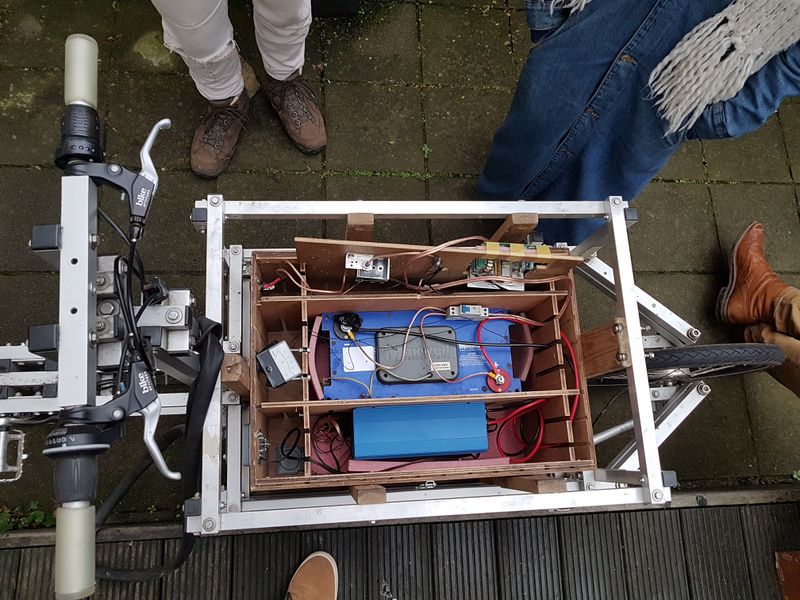(Page créée avec « {{ {{tntn|Tuto Details}} |SourceLanguage=none |Language=fr |IsTranslation=0 |Main_Picture=Energy_module_for_People_Pedal_Power_20171111_154429.jpg |Licences=Attribution (C... ») |
|||
| Ligne 1 : | Ligne 1 : | ||
{{ {{tntn|Tuto Details}} | {{ {{tntn|Tuto Details}} | ||
| − | |||
| − | |||
| − | |||
|Main_Picture=Energy_module_for_People_Pedal_Power_20171111_154429.jpg | |Main_Picture=Energy_module_for_People_Pedal_Power_20171111_154429.jpg | ||
|Licences=Attribution (CC BY) | |Licences=Attribution (CC BY) | ||
| Ligne 21 : | Ligne 18 : | ||
|Cost=2000 | |Cost=2000 | ||
|Currency=EUR (€) | |Currency=EUR (€) | ||
| − | |Tags=energy | + | |Tags=energy, supercapacitor, inverter, energy conversion |
| + | |SourceLanguage=none | ||
| + | |Language=fr | ||
| + | |IsTranslation=0 | ||
}} | }} | ||
{{ {{tntn|Introduction}} | {{ {{tntn|Introduction}} | ||
| − | |Introduction=First the overview of the system. In words, we are harvesting the energy from | + | |Introduction=First the overview of the system. In words, we are harvesting the energy from stationary bikes. The energy is converted to regular AC power. We also monitor the energy flow wit the Open Energy Monitoring system. The bike stands we designed fit regular bikes. The bike wheel drives an electric motor with converts the mechanical energy into electric energy. The DC power is conducted through a diode and through a current sensor. Then the different cables are connected to the supercapacitor. This is the common point. From the supercapacitor we draw the power for the solar inverter that converts the fluctuating DC power to regular AC power. We monitor the power before the common point. An Arduino takes in the values of the current and voltage and transfers it to a Raspberry Pi that logs the data. An app on the smartphone allows to visualize the data. |
}} | }} | ||
{{ {{tntn|Materials}} | {{ {{tntn|Materials}} | ||
| − | |Material= | + | |Material=- Supercapacitor (here 165F 48V) |
| − | |Tools= | + | |
| + | - Inverter (here 800VA) | ||
| + | |||
| + | - Electric connections, switched and wires | ||
| + | |||
| + | - DC/DC converter | ||
| + | |Tools=- Soldering iron | ||
| + | |Prerequisites={{ {{tntn|Prerequisites}} | ||
| + | |Prerequisites=People pedal powered computer charger | ||
| + | }}{{ {{tntn|Prerequisites}} | ||
| + | |Prerequisites=Basic Multi-Modular Frames for Cargo Bikes - Stackable watertight laser cut boxes by Velo M2 | ||
| + | }} | ||
}} | }} | ||
{{ {{tntn|Separator}}}} | {{ {{tntn|Separator}}}} | ||
Version du 19 février 2019 à 19:40
Here you can find the Open Hardware documentation of the People Pedal Power, the system that makes energy out of bikes.
There are 3 chapters,
The bike stand The electric conversion The energy moitoringTo find out more about the Vélo M² project and other project, visit www.velom2.be.
Difficulté
Difficile
Durée
2 mois
Catégories
Électronique
Coût
2000 EUR (€)
Sommaire
Introduction
First the overview of the system. In words, we are harvesting the energy from stationary bikes. The energy is converted to regular AC power. We also monitor the energy flow wit the Open Energy Monitoring system. The bike stands we designed fit regular bikes. The bike wheel drives an electric motor with converts the mechanical energy into electric energy. The DC power is conducted through a diode and through a current sensor. Then the different cables are connected to the supercapacitor. This is the common point. From the supercapacitor we draw the power for the solar inverter that converts the fluctuating DC power to regular AC power. We monitor the power before the common point. An Arduino takes in the values of the current and voltage and transfers it to a Raspberry Pi that logs the data. An app on the smartphone allows to visualize the data.
Matériaux
- Supercapacitor (here 165F 48V)
- Inverter (here 800VA)
- Electric connections, switched and wires
- DC/DC converter
Outils
- Soldering iron
Étape 1 -
Draft

 Français
Français English
English Deutsch
Deutsch Español
Español Italiano
Italiano Português
Português